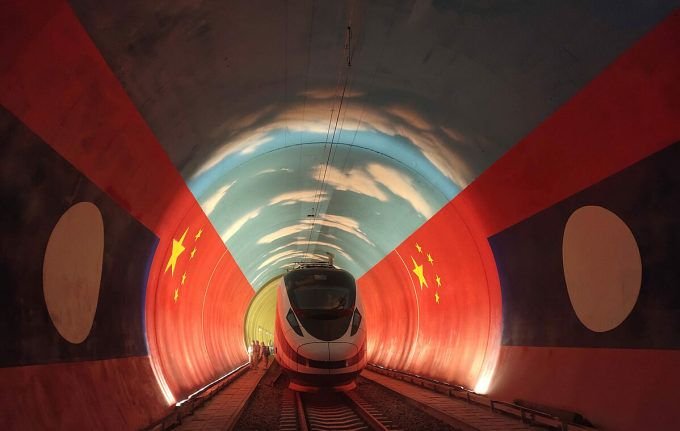
5 years China pushes Laos high-speed railway to its destination 2
Laos and China began negotiating a high-speed railway connecting the two countries in 2001, eight years later they confirmed plans to carry out the project.
The Laos-China high-speed railway is designed to be 414 km long from the border town of Boten, bordering China’s Yunnan province, to the capital Vientiane.
The Lane Xang high-speed train passes through the China-Laos border tunnel on October 15.
6 contractors from CNRG companies are responsible for carrying out the project.
The reason seems to be because Laos gives Chinese companies more freedom in the construction process than some other Southeast Asian countries.
In early 2019, the parties responsible for construction reported that half of the project had been completed and was on schedule for completion in December 2021.
Despite many difficulties as a result of epidemic prevention measures, Lao and Chinese engineers still tried to stick to the plan.
`We will complete construction and put the railway into a state of full operational readiness on December 2,` said Xiao Qianwen, leader of the Lao-China Railway Company, the joint venture in charge of construction and operation.
`We will not change the schedule and are striving for that goal. More than 90% of the engineering work has been completed. We are also carrying out operational preparation work,` Xiao added.
At the end of June, China Railway Company No. 5 (CREC-5) completed construction of the main structure of the longest bridge along the Laos-China railway.
At the northern end of the line, China Railway Construction Engineering Group (CRCEG) also topped off a station in Boten town, the gateway between the two countries.
Lei Chao, project manager at China Railway Company No. 2 (CREC-2), said in late June that they `will have all the tracks installed by mid-August,` adding that the team
The Laos-China railway was constructed so quickly that it became a typical project of China’s Belt and Road initiative.
However, the articles also acknowledge many major challenges during the construction process, the first being the terrain.

Workers at the construction site of the Laos-China railway, located in the northern suburbs of Vientiane, Laos, on February 10.
Complicated geographical factors and poor traffic conditions are also major obstacles.
In addition, the project makes a part of Lao people feel dissatisfied, because they believe that the government’s relocation compensation policy is not satisfactory.
Controversies over these compensation regulations caused project delays and increased costs.

The high-speed train stopped at the Lao town of Boten on the Laos-China railway on October 15.
However, despite the problems surrounding the project, Lao officials still tried to mobilize support and convince that the railway would help people escape poverty.
`The Laos-China Railway will lay a new foundation to help attract foreign investment. Laos will definitely take advantage to participate in the global and regional industrial chain. In other words, the project will not only promote
On October 16, the first high-speed train on the Laos-China railway was delivered to Vientiane and handed over to the operator.
Somphone Inleuangsy, 24 years old, is one of more than 600 young Laotians trained to operate the railway.
`The Chinese have a saying ‘If you want to get rich, first build roads’. I hope that with the Laos-China railway, Laos will soon become prosperous, becoming a transportation center in Southeast Asia,







